G.I.C.
A Weekly Outlook and Analysis of the
Global Investment Climate
26 February 2002
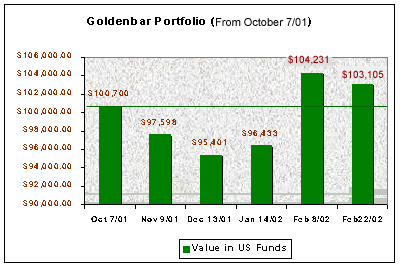
WEEKLY
GLOBAL MARKET REVIEW
08 February 2002 - 22 February
2002
| Global Equities |
LAST
|
± CHANGE
|
%
CHANGE
|
| Nikkei | 10357 | + 671 | 6.9% |
| Dow Industrials | 9968 | + 224 | 2.3% |
| SP500 | 1090 | - 6 | - 0.6% |
| TSE 300 | 7427 | - 108 | - 1.4% |
| FTSE 100 | 5051 | - 77 | -1.5% |
| Euro Top 100 | 267 | - 5 | - 1.8% |
| Nasdaq Comp | 1725 | - 94 | - 5.2% |
| Best US Stock Sectors |
LAST
|
± CHANGE
|
%
CHANGE
|
| AMEX Oil Services Index | 91 | + 8 | 10.1% |
| AMEX Natural Gas Index | 171 | + 8 | 5.0% |
| AMEX Airline Index | 93 | + 5 | 4.8% |
| Dow Jones Chemical Index | 43 | + 2 | 4.7% |
| AMEX Oil Index (XOI) | 520 | + 17 | 3.4% |
| US Yields | LAST | ± CHANGE |
%
CHANGE
|
| US 30 Year Treasury | 5.34 | - 0.04 | - 0.7% |
| US 10 Year Note | 4.83 | - 0.05 | - 1.1% |
| Currencies | LAST | ± CHANGE |
%
CHANGE
|
| US Dollar Index | 118.6 | - 0.60 | - 0.5% |
| Dollar / Euro | 1.143 | - 0.004 | - 0.4% |
| Dollar / Yen | 134.0 | - 0.4 | - 0.3% |
| Commodities | LAST | ± CHANGE |
%
CHANGE
|
| CRB | 191.7 | - 0.1 | NIL |
| Crude (WTIC) | 21.07 | + 0.81 | 4.0% |
| Silver (December) | 4.40 | - 0.06 | - 1.35% |
| Gold Ratios | LAST | PREVIOUS | ± CHANGE |
| Gold (vs dollar) | 294 | 304 | - 10.00 |
| Gold/Silver | 66.82 | 68.16 | - 1.34 |
| Gold/Oil | 13.95 | 15.00 | - 1.05 |
| Gold/CRB | 1.53 | 1.59 | - 0.06 |
| Economic Releases This Week (busy week): | |
| Monday |
|
| Tuesday |
|
| Wednesday |
|
| Thursday |
|
| Friday |
|
Are we too bearish on the Dow and S&P 500? In a sense, yes. We know that because our model went short the latter in November with 20 percent of the account. Even last year we were early by a few months. But then sometimes we came within days of perfect timing. Still, our position has been holding water, though with only a paltry 10-point profit as a buffer (less at the time of writing). We prefer the S&P 500 to the Dow due to the Dow's enduring relative strength and our stab at picking a top in the broader market after a meaningful bounce based on the notion that it is still a bear market.
It may be tempting for the critic to believe that is our bias, but he'd be dead wrong.
Nevertheless, this introspection of our outlook comes on four bullish sessions in the past six where the tape has flared up like it did back in the days that the bulls were in their prime. Specifically, the Dow bulls have been flexing their biceps within a still weak broad market, at least as measured by the technical condition of the broad market averages like the S&P 500, NYSE Composite, and the Nasdaq Composite.
Yet, it seems that the weak technical condition of the major market averages doesn't seem to square with the graph of the 2-year advance-decline line for the NYSE below. We consider this to be the second reason for reviewing our bear market hypothesis.

This chart is one argument the bulls like to point at to illustrate their case. According to this graph, the broader market has been trending up throughout the entire 2-year bear market. It's odd because there are five hundred stocks in the S&P 500, and it has been trending down along with the NYSE composite for two years. What this must imply is that it is the large capitalization stocks that have been weighing on the averages over this time, while there must have been a "stealth" bull market in the broader sense.
Even so, it simply does not reconcile with our scrutiny of the charts. Of the 24 non S&P sectors that we watch, the only ones that continue to display bull market behavior or uphold primary bullish parameters are Morgan Stanley's Commodity Related Stocks Index, Morgan Stanley's Healthcare Products Index, as well as the AMEX Oil Index, the Philadelphia Forest/Paper Products Index, and the Dow Jones Real Estate Index. If you weren't counting that's five out of twenty four, which doesn't check with what is implied by the graph of the A/D line above.
Perhaps there are more stocks in these particular indexes, we didn't check. It could be that our examination of the charts is off somewhat. So we checked.
Over the two-year period, which the above A/D line covers, four of the twenty-four sectors are meaningfully higher, while eight are meaningfully lower. Seven are higher by a margin and five are lower by a margin. But this coverage is a broad (though somewhat random) cross section of the US stock market instead of just the NYSE, which itself is trending down. Since the NYSE A-D line has been trending up then we must conclude this divergence is the result of the affect of fewer but larger cap issues on the big board.
|
From Stockcharts.com: The Advance-Decline (AD) line is the culmulative total for the difference between the number of advancing stocks and the number of declining stocks in a given market. The AD line for the New York Stock Exchange (NYSE) is the most widely used measure of market breadth. If there are more advances than declines, the AD is a positive number; if there are more declines, the AD number is negative. That daily number is added to the cumulative AD line. The AD line gives us information on whether the majority of stocks are following the trend of the commonly followed stock indices. The actual value of the AD line isn't important -- the shape of the curve is the key information that analysts pay attention to. Is it moving in the same direction as the underlying major market average? If the two lines are diverging, it's a warning signal for a possible trend reversal - http://stockcharts.com/charts/$NYAD.html |
The 20-day moving average of the S&P 500 advance-decline line better represents what we actually see in most charts. As you can see from the graph below it has really gone nowhere over this period (we couldn't get a two year graph, but recall that the NYSE AD line performed better last year as well).
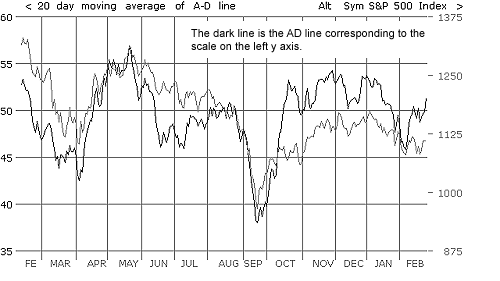
20 day moving average of S&P 500 Advance/Decline
line
Within the S&P (industrials) the following sectors have been either trending up since 2000, or are maintaining primary bullish parameters:
- Agricultural Products,
- Aluminum,
- Alcoholic Beverage,
- Chemicals,
- Construction,
- Food Distributors,
- Electronics,
- Packaged Foods,
- Footwear,
- Gaming,
- Gold,
- Hardware,
- Homebuilders,
- House wares,
- Household Appliances,
- Leisure Products,
- Manufacturing (diversified),
- Oil,
- Oil Drillers,
- Paper,
- Publishing (both sectors covered by S&P),
- Retail Building Supplies,
- Department Stores,
- Drugs (retail),
- General Merchandise,
- Specialty Stores,
- Textiles,
- Tobacco,
- Trucks, and
- All (eight) Healthcare sectors.
That's 38 out of 86 indexes, and not all of those in a primary bullish sequence have been trending up over the past two years. By the way, I've actually wanted to show you a graph of the Agricultural Products sector for some time now.
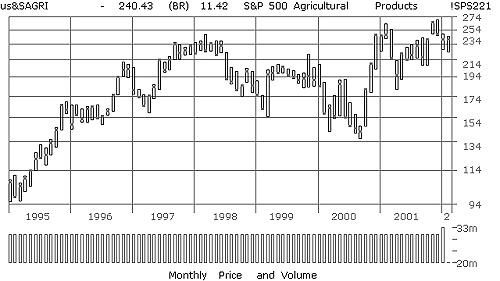
S&P Agricultural Products
Then of course there are the S&P Transports, Utilities, and Financials.
The three utilities indexes had a terrific 2000, but turned down sharply last year, as you know. All three are lower than they were two years ago.
The four Transportation sectors appear mixed in a primary analysis of trends, but all are higher than they were at the beginning of 2000. Air Freight stocks have shown the best performance in the group.
As for the eleven financial indexes in the S&P only three (Savings & Loan, Consumer Finance, and Insurance - specifically the property and casualty - shares) have made bullish gains since 2000, though eight are higher in total.
The bank (regional and money center) sectors have been mired in a wide four-year trading range that could easily become a major topping formation with the benefit of a little hindsight, while the investment banks lost ground over the past 2 years. The four insurance sectors performed well.
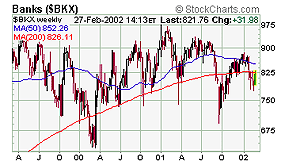
Phili Bank index
Perhaps one conclusion we may draw from the first advance/decline line is that fewer and fewer stocks have been declining and the weakest shares happen to be the ones carrying the most statistical weight in the broad market averages. This might mean that the next bull market is around the corner. Or maybe not.
Maybe we should take heed. After all, the Fed lowered rates about fifty times in the past twelve months alone. Maybe it's beginning to work.
But maybe the uptrending advance / decline line is only a correction in the first place from the big decline that began in 1998/99.
Let's consider the facts: since peaking in 1998, this indicator has decoupled from the trend in the averages. It has gone down while the major market averages went up, and it has gone up while they have been going down. Have a look at the 12 year picture of what's going on:

Compliments of ShareLynx.com
However, despite the fact that bulls place so much importance on an indicator today that they outright rejected when it didn't read like they wanted, how we interpret the indicator is that the broad market downturn in 1998/99 finally weighed on the major market large cap leadership by 2000. Since the last stocks to rally were the large capitalization issues (technology or otherwise throughout 1999) it goes without saying then that as they capitulated their influence on the averages outweighed the broader market for a time, which had already been declining for two years (since 1998) and was in the process of correcting that contracting breadth, evidently, while bears focused on the more frothy issues previously driving the bull market.
Thus, the gain since 2000 might just denote a correction in an overall broader bear market (in breadth). Maybe breadth is about to deteriorate again. Why should we believe that the current expansion in breadth signals anything but a pause in an enormous bear market, particularly when most of the averages and sectors continue to weaken within their own technically defined bear markets? Besides, total breadth (of all US markets) is dragged down by this unending drama:
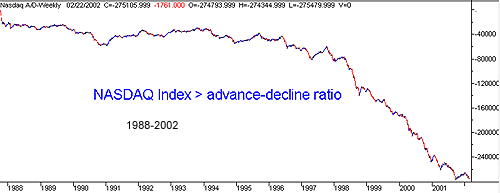
Compliments of ShareLynx.com
But now that we see a meaningful rally in the large capitalization stocks even if within fresh broader market weakness (the S&P 500 and Nasdaq composite sent us sell signals in late January) should we be surprised? After all, it may only represent the transition to renewed broad bearish leadership, and some of the Dow stocks may indeed be perceived as a last bastion of safety, to a degree. At least if investors still listen to CNBC that is.
It hasn't gone unnoticed by us that the Dow Industrials in particular have been relatively resilient throughout the two-year bear market. Even relative to other large cap stocks, the Dow's blue chips have been a reluctant participant in the bear market at often-crucial times.
Nonetheless, even here the bearish argument has been generally gaining ground.
Consider a subscription to read the rest of the report:
|
Good luck,
Edmond J. Bugos
The GoldenBar Global Investment Climate is not a registered advisory service and does not give investment advice. Our comments are an expression of opinion only and should not be construed in any manner whatsoever as recommendations to buy or sell a stock, option, future, bond, commodity or any other financial instrument at any time. While we believe our statements to be true, they always depend on the reliability of our own credible sources. Of course, we recommend that you consult with a qualified investment advisor, one licensed by appropriate regulatory agencies in your legal jurisdiction, before making any investment decisions, and barring that, we encourage you toconfirm the facts on your own before making important investment commitments.